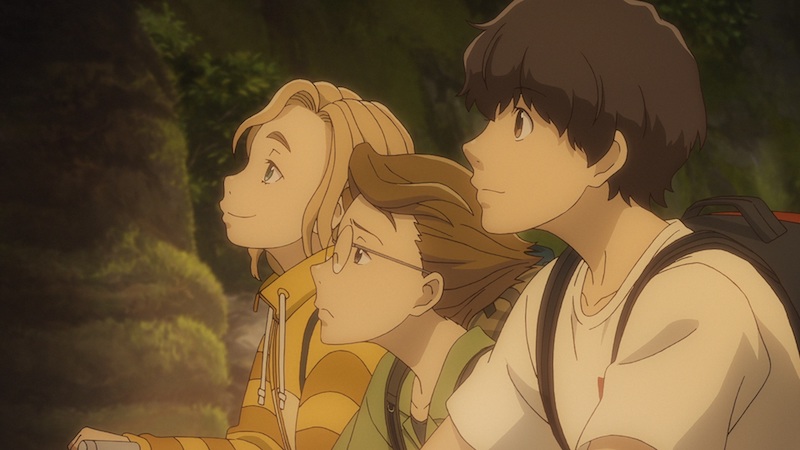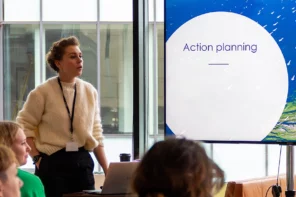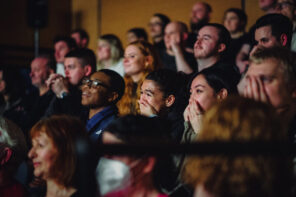Neil Hepburn writes how genre cinema is making a come-back with This Way Up 2022 guests Melissa Gueneau (Programmer, Mayhem Film Festival and Warwick Arts Centre), Andrew Partridge (Founder, Scotland Loves Anime) and Nia Edwards-Behi (Co-director, Abertoir Horror Festival) with chair Manon Euler (Programmes Manager, Film Hub Midlands) discussing its resurgence.
4.00pm at a conference feels like the graveyard slot. The early start is catching up. The caffeine is wearing off. The cinema seats at the DCA are dangerously comfortable. How to make it through the late afternoon slump? This Way Up’s answer: give the stage to genre programmers. And ask them this – who is the best ghost?
Three programmers working in horror and anime seem uniquely well-placed to answer the question. But first, chair Manon Euler gauged the chill factor by asking the panel how their recent festivals went and, in a post-pandemic context, what did they notice about their audiences?
Melissa Gueneau shared the uplifting news that at Mayhem they had healthy audiences, with numbers approaching pre-pandemic levels and full-festival passes selling more than ever before. It was a different story for Scotland Loves Anime, with Andrew Partridge lamenting the collapse of the CMI, eliminating the Filmhouse (the key venue for 13 years of this Japanese animation festival).
An alternative venue was found and Andrew considers the festival a success, but numbers were impacted and still down by about 40% from the last pre-pandemic festival. Nia Edwards-Behi, in the wake of this year’s outstandingly named Abertoir Film Festival, shared that 2022’s edition saw a return to full capacity, with a smaller online element. Coming straight off the back of the six-day festival, she’s yet to crunch the numbers but said that retaining a hybrid model following the pandemic years had been extremely well received.
What about the practicalities of programming for diverse audiences and thinking beyond horror as being made by and for white men only? Nia acknowledged that a certain stereotype of the metalhead horror fan (nothing wrong with metalheads) has some basis in reality but that highlighting diversity in their programme has been impactful. Diversity on screen translates to the audiences.
Genre coming out of the shadows
Collaboration can also be key – like the one Abertoir had with Bristol Black Horror Club contributing to more diverse audiences who they hope will start to become part of that core demographic. In terms of anime, Andrew spoke of screening films with context from a more diverse range of talent – for example inviting female anime filmmakers for in-person screenings.
The panel was also in agreement that genre programming is not relegated to the margins. Horror and anime are broad churches that open up a wide array of options for curation and creativity. Melissa proposed that the existence of great horror festivals outside of London and around the country (such as host city Dundee’s ‘Dundead’) suggests that horror is not as niche as people may think.
Andrew discussed anime in terms of its shift from the margins to the mainstream. Despite a more mainstream presence now, the roots of cinematic anime – 1998’s Akira for example – embody a counterculture spirit that sits well with independent cinema venues. These venues tend to be much more supportive and accessible for festival programming throughout the year.
One question, beamed through the anonymous techno-nightmare medium of ‘Slido’, asked if genre cinema is more fun for audiences? For Melissa, that’s a matter of opinion with horror – some people just don’t like going into a dark room with the intention of scaring themselves. Andrew answered the question by pointing out that there had been more laughs in this session than any other. Everyone laughed!
Then a final ominous question from Slido arrived, as if hauntingly dredged up from the underworld. Who is the best ghost? A chill descended on the room. Someone coughed nervously. The lights flickered. Nia stepped up to answer. She didn’t mince her words. The best ghost is… Sadako*. Nods of reverence filtered through the audience. Everyone on the panel agreed, as if daring to mention another would unleash some unspeakable evil. I guess genre programming is not for the faint-hearted.
* If you don’t know who Sadako is, you have exactly one week to find out in order to break a terrible curse.






